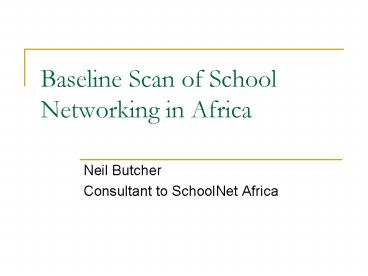Baseline Scan of School Networking in Africa - PowerPoint PPT Presentation
1 / 14
Title:
Baseline Scan of School Networking in Africa
Description:
Of these, 16 questionnaires were returned. To complement the quantitative data ... Useful to conclude with a quotation from a SchoolNet practitioner about the ... – PowerPoint PPT presentation
Number of Views:35
Avg rating:3.0/5.0
Title: Baseline Scan of School Networking in Africa
1
Baseline Scan of School Networking in Africa
- Neil Butcher
- Consultant to SchoolNet Africa
2
Research Approach
- 28 email questionnaires sent to SchoolNets in 26
African countries - Of these, 16 questionnaires were returned
- To complement the quantitative data obtained from
the questionnaires, telephonic interviews were
conducted by SchoolNet Africa to follow up on
specific issues in more detail. - Main aim was to provide an overview of school
networking in Africa. - Describe organizational structure and issues
faced by SchoolNets - Review of services provided
- Additional details on context of member schools
3
Organizational Issues
- First SchoolNet organization in Africa started,
in 1996, in Egypt - Most SchoolNets (31) started in 1999, 25 in
1998 and 13 each in 2001 and 2002. - In 43 of cases, there are 25 or fewer schools
and in 13 of cases there are between 25 and 50
and between 50 and 100 schools. - 77 of member schools are estimated to be in
urban areas. It is thus likely that schools
participating in SchoolNets at present are the
better resourced in each country. - 47 of SchoolNets are structured as an
independent NGO, 26 are part of an international
programme, and 16 are based in the Ministry of
Education or Telecommunication.
4
Sources of Funding
5
Difficulties Faced by SchoolNets
6
Difficulties Faced by SchoolNets
- Most difficulties are as a result of local of
buy-in from various government agencies and
stakeholders and minimal understanding of the
benefit accrued to supporting SchoolNet project. - It has been difficult to engage with some
provincial government processes. - We have difficulties to engage the partners and
government in the program. - As ICT training has not been institutionalised
in our schools, it is not considered a part of
the curriculum and appears as extra work for
youth and youth cyber club facilitators.
7
Areas in Which SchoolNets Intend to Develop
8
Activities in Which SchoolNets are Involved
9
Number of Teachers Trained by SchoolNets
10
Number of Learners Accessing Computers on a
Weekly Basis
11
Software Typically Available at Schools
12
Factors Considered Important in Technology Choice
- Buy-in and involvement of the school (including
the principal, teachers, and students). - A champion who will drive the project/programme
at the school level. - Availability of qualified people who are ready to
be trained to work within the schools. - Sustainability and management factors.
- Initial versus maintenance costs it is better
to pay a relatively high initial cost and secure
a system that requires minimum technical support.
This applies to both software and hardware
choices. - Scalability, both in terms of physical
infrastructure and actual technical resources - Technology design Schools want technology that
cannot only be operated by a teacher but can also
be maintained reasonably easily by school staff.
13
Use of Computers for Community Activities
14
Conclusion
- Many achievements made with respect to school
networking across the continent - Vast range of challenges still to be overcome
- Useful to conclude with a quotation from a
SchoolNet practitioner about the positive
educational effects witnessed as they worked to
use ICT for education - The most common expected effect is improvement
in performance in public examinations. We are not
aware of any direct measure of this though we
believe that it is certainly being realized to
some degree. However the good example we have is
one of students from what were perceived as poor
high-density schools producing world-class
educational websites and collaborative project
material. By using ICTs, those of our students
who have access seem to get better at expressing
themselves not just to people around them but
also to a worldwide audience. The result is that
they develop a better self-image, personal and
national identity and yet at the same time
realizing that they are part of a global
community.































